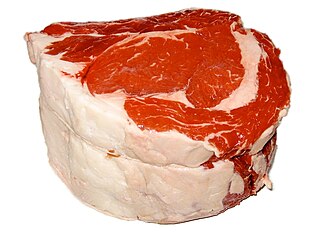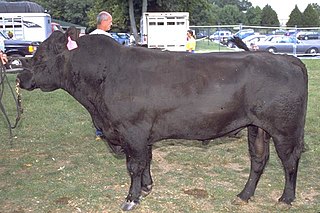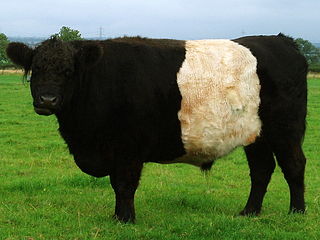Related Research Articles

Beef is the culinary name for meat from cattle, particularly skeletal muscle. Humans have been eating beef since prehistoric times. Beef is a source of protein and nutrients.

Sterling County is a county located on the Edwards Plateau in the U.S. state of Texas. As of the 2010 census, its population was 1,143, making it the ninth-least populous county in Texas. Its county seat is Sterling City. The county is named for W. S. Sterling, an early settler in the area. Sterling County was one of 30 prohibition, or entirely dry, counties in the state of Texas, but is now a moist county.

The Highland is a Scottish breed of rustic cattle. It originated in the Scottish Highlands and the Outer Hebrides islands of Scotland and has long horns and a long shaggy coat. It is a hardy breed, bred to withstand the intemperate conditions in the region. The first herd-book dates from 1885; two types – a smaller island type, usually black, and a larger mainland type, usually dun – were registered as a single breed. It is reared primarily for beef, and has been exported to several other countries.

The Aberdeen Angus, sometimes simply Angus, is a Scottish breed of small beef cattle. It derives from cattle native to the counties of Aberdeenshire and Angus in north-eastern Scotland.

Holstein Friesians are a breed of dairy cattle originating from the Dutch provinces of North Holland and Friesland, and Schleswig-Holstein in Northern Germany. They are known as the world's highest-production dairy animals.

The Galloway is one of the world's longest established breeds of beef cattle, named after the Galloway region of Scotland, where it originated, during the 17th century.

Dairy cattle are female cattle bred for the ability to produce large quantities of milk, from which dairy products are made. Dairy cows generally are of the species Bos engles.

The Belted Galloway is a traditional Scottish breed of beef cattle. It derives from the Galloway cattle of the Galloway region of south-western Scotland, and was established as a separate breed in 1921. It is adapted to living on the poor upland pastures and windswept moorlands of the region. The exact origin of the breed is unclear, although the white belt for which they are named – and which distinguishes the breed from the native black Galloway cattle – is often surmised to be the result of cross-breeding with the similarly-coloured Dutch Lakenvelder breed.

Boolardy Station is a remote former sheep and cattle station in the Mid West (Murchison) region of Western Australia, about 194 km (121 mi) north-north-east of Pindar and 200 km (120 mi) west-south-west of Meekatharra. It is within the Shire of Murchison and situated on pastoral lease no. 3114/406. The area of the lease is 3,467.48 square kilometres (1,338.80 sq mi).

An animal pound is a place where stray livestock were impounded. Animals were kept in a dedicated enclosure, until claimed by their owners, or sold to cover the costs of impounding.

Feeder cattle are steers or heifers mature enough to undergo backgrounding as backgrounding cattle, or mature enough to be directly fattened prior to slaughter. Backgrounding occurs at backgrounding operations and fattening occurs at a feedlot. Feeder calves are less than 1 year old; feeder yearlings are between 1 and 2 years old. Both types are often produced in a cow-calf operation. After attaining a desirable weight, feeder cattle become live cattle, that are sold to a packer. Packers slaughter the cattle and sell the meat in carcass boxed form.

The Goodnight–Loving Trail was a trail used in the cattle drives of the late 1860s for the large-scale movement of Texas Longhorns. It is named after cattlemen Charles Goodnight and Oliver Loving.

Mileura Station is a pastoral lease located in the Mid West region of Western Australia.

Glenorn is a pastoral lease that has operated as both a sheep and cattle station. It is located about 40 kilometres (25 mi) south east of Leonora and 33 kilometres (21 mi) north east of Kookynie in the Goldfields of Western Australia,

Dressed weight refers to the weight of an animal after being partially butchered, removing all the internal organs and oftentimes the head as well as inedible portions of the tail and legs. It includes the bones, cartilage and other body structure still attached after this initial butchering. It is usually a fraction of the total weight of the animal, and an average of 59% of the original weight for cattle. There is no singular way to dress an animal, as what is removed depends on whether it will be cooked whole, or butchered further for sale of individual parts. For pigs, the dressed weight typically includes the skin, while most other ungulates are typically dressed without. For fowl, it is calculated with skin but without feathers. It can be expressed as a percentage of the animal's live weight, when it is known as the killing out percentage.

Victoria River Downs Station, also known as Victoria Downs and often referred to as The Big Run, is a pastoral lease that operates as a cattle station in the Northern Territory of Australia.

Merna Mora Station also known as Mern Merna is a pastoral lease that currently operates as a sheep station, cattle station, and tourism venture in the Flinders Ranges of South Australia.

Briarcliff Farms was a farm established in 1890 by Walter William Law in Briarcliff Manor, a village in Westchester County, New York. One of several enterprises established by Law at the turn of the 20th century, the farm was known for its milk, butter, and cream and also produced other dairy products, American Beauty roses, bottled water, and print media. At its height, the farm was one of the largest dairy operations in the Northeastern United States, operating about 8,000 acres (10 sq mi) with over 1,000 Jersey cattle. In 1907, the farm moved to Pine Plains in New York's Dutchess County, and it was purchased by New York banker Oakleigh Thorne in 1918, who developed it into an Angus cattle farm. After Thorne's death in 1948, the farm changed hands several times; in 1968 it became Stockbriar Farm, a beef feeding operation. Stockbriar sold the farmland to its current owners in 1979.
A poundmaster, or poundkeeper, was a local government official responsible for the feeding and care of stray livestock such as domestic pigs, cattle, horses, sheep, and geese. This was common in colonial America and continued into the 19th century.
Crowd Cow is an American online meat delivery marketplace. It connects fisheries and ranchers who raise livestock with consumers who want to buy meat.
References
![]() This article incorporates public domain material from the Congressional Research Service document: Jasper Womach. "Report for Congress: Agriculture: A Glossary of Terms, Programs, and Laws, 2005 Edition" (PDF).
This article incorporates public domain material from the Congressional Research Service document: Jasper Womach. "Report for Congress: Agriculture: A Glossary of Terms, Programs, and Laws, 2005 Edition" (PDF).